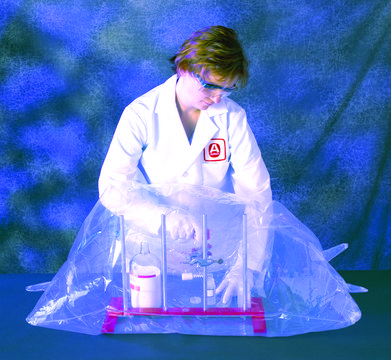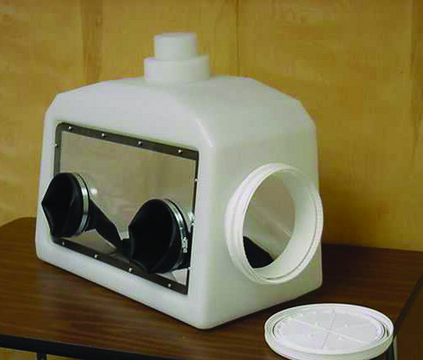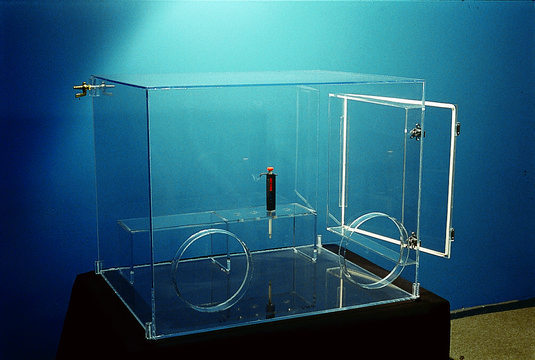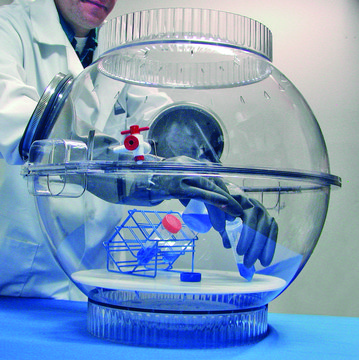Z564427
Aldrich® AtmosBag
two-hand, side entry, non-sterile, size mini, closure type, Zipper-lock
About This Item
Recommended Products
size
mini
sterility
non-sterile
feature
closure type Zipper-lock
W × L × H
25 in. × 30 in. × 12 in., average inflated dimensions
W × L
32 in. × 24.25 in. , deflated dimensions
gas volume
1.75 ft3
opening diam.
12 in. , 2 ports
Looking for similar products? Visit Product Comparison Guide
General description
For Field Sampling: AtmosBag slips over the top of cans and drums to blanket with inert gas and isolate vapors and dusts during sampling operations. Minimizes worker exposure and preserves the integrity of the sampled bulk material. AtmosBag serves as a portable laboratory for conducting tests, crime scene investigations, and other applications where a clean isolated chamber is needed.
AtmosBag with Tape-seal closure: The opening of AtmosBag is taped and folded over for a gas-tight seal. Each AtmosBag is supplied with a strip of removable sealing tape.
AtmosBag with Zipper-lock closure: The opening of AtmosBag is closed with a Zipper-lock for a gas-tight seal. The opening is slightly smaller than the width of the bag due to the width of the zipper. Excellent for applications that require repeated access to bag contents and for emergency isolation.
Specifications:
- Constructed of sturdy 0.003 in. gauge polyethylene that is polished for good clarity
- Seams are heat-sealed for strength and inflation tested to be leak-free
- Inlet ports are provided for laboratory gas, vacuum, and electrical lines
- AtmosBag is not fire-retardant or intended for prolonged contact with solvents, vapors, or chemicals
- Can be used in an Argon environment
- Twoports on each bag. One on each side of the bag.
Legal Information
Choose from one of the most recent versions:
Certificates of Analysis (COA)
Sorry, we don't have COAs for this product available online at this time.
If you need assistance, please contact Customer Support.
Already Own This Product?
Find documentation for the products that you have recently purchased in the Document Library.
Which document(s) contains shelf-life or expiration date information for a given product?
If available for a given product, the recommended re-test date or the expiration date can be found on the Certificate of Analysis.
How do I get lot-specific information or a Certificate of Analysis?
The lot specific COA document can be found by entering the lot number above under the "Documents" section.
How do I find price and availability?
There are several ways to find pricing and availability for our products. Once you log onto our website, you will find the price and availability displayed on the product detail page. You can contact any of our Customer Sales and Service offices to receive a quote. USA customers: 1-800-325-3010 or view local office numbers.
What is the Department of Transportation shipping information for this product?
Transportation information can be found in Section 14 of the product's (M)SDS.To access the shipping information for this material, use the link on the product detail page for the product.
What is the temperature range that the Aldrich AtmosBag glove bags can withstand?
The AtmosBags are made out of polyethylene, which tends to become brittle below about -100°C, and softens/melts at above 80°C. Based on that information, we would recommend using the AtmosBag well within that temperature range of -100°C to +80°C.
My question is not addressed here, how can I contact Technical Service for assistance?
Ask a Scientist here.
Our team of scientists has experience in all areas of research including Life Science, Material Science, Chemical Synthesis, Chromatography, Analytical and many others.
Contact Technical Service


